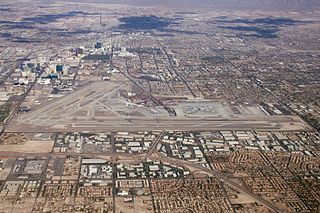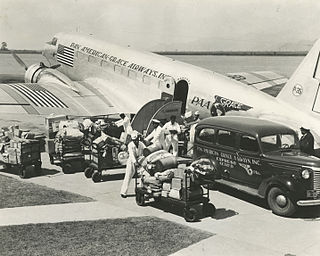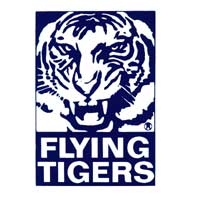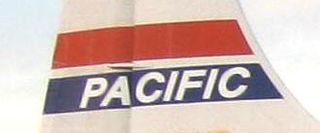The topic of this article may not meet Wikipedia's notability guidelines for companies and organizations .(February 2020) |
| Founded | 1946 |
|---|---|
| Ceased operations | 1966 |
AAXICO was an airline based in the United States.
The topic of this article may not meet Wikipedia's notability guidelines for companies and organizations .(February 2020) |
| Founded | 1946 |
|---|---|
| Ceased operations | 1966 |
AAXICO was an airline based in the United States.
AAXICO, the American Air Export and Import Company, was founded in 1946 in Miami Beach, Florida.
AAXICO's initial flight service consisted of five daily flights from New York to Atlantic City geared toward the horse racing industry, with the last flight scheduled to wait until after the last race. [1] By 1956, AAXICO was registered as an all-cargo airline. AAXICO temporarily suspended flight operations on June 30, 1960, in negotiations with Air Line Pilots Association, International. [2] Prior to its merger, AAXICO had a Department of Defense contract to carry 25,000 lbs of cargo daily. [3] Its airline operations ceased in 1966, when they were sold to Saturn Airways. [4]
AAXICO is now an airline support company based in Doral, Florida. [5]

The AAXICO fleet consisted of the following aircraft:[ when? ]
| Aircraft | Total | Routes | Notes |
|---|---|---|---|
| DC-3 | 9 | Leased off 6 DC-3s after slump in 1947 | |
| C-46 | 18 | In 1961 | |
| DC-6 |

Harry Reid International Airport is an international airport in Paradise, Nevada, and is the main government airport for public use in the Las Vegas Valley, a metropolitan area in the U.S. state of Nevada, about 5 miles (8 km) south of Downtown Las Vegas. The airport is owned by the Clark County Commission and operated by the Clark County Department of Aviation. LAS covers 2,800 acres (11.3 km2) of land.

Reeve Aleutian Airways was an airline headquartered in Anchorage, Alaska, United States. It ceased operations on December 5, 2000.

Braniff Airways, Inc., operating as Braniff International Airways, from 1948 until 1965, and then Braniff International from 1965 until closure, was an American airline that flew air carrier operations from 1928 until 1982 and continues today as a retail, branding and licensing company, administering the former airline's employee pass program and other administrative duties. Braniff's routes were primarily in the midwestern and southwestern United States, Mexico, Central America, and South America. In the late 1970s it expanded to Asia and Europe. The airline ceased air carrier operations in May 1982 because of high fuel prices, credit card interest rates and extreme competition from new airline startups created by the Airline Deregulation Act of December 1978. Two later airlines used the Braniff name: the Hyatt Hotels-backed Braniff, Inc. in 1983–89, and Braniff International Airlines, Inc. in 1991–92.

The Fokker F27 Friendship is a turboprop airliner developed and manufactured by the Dutch aircraft manufacturer Fokker. It is the most numerous post-war aircraft manufactured in the Netherlands; the F27 was also one of the most successful European airliners of its era.
Texas International Airlines Inc. was a United States airline, known from 1940 until 1947 as Aviation Enterprises, until 1969 as Trans-Texas Airways (TTa), and as Texas International Airlines until 1982, when it merged with Continental Airlines. It was headquartered near William P. Hobby Airport in Houston, Texas.
This is a list of aviation-related events from 1958:

Pan American-Grace Airways, also known as Panagra, and dubbed "The World's Friendliest Airline" was an airline formed as a joint venture between Pan American World Airways and Grace Shipping Company. On September 13, 1928, a small single-engine Fairchild airliner flew from Lima, Peru, to Talara, Peru, which marked not only the beginning of Pan American Grace Airways but also the inauguration of scheduled air transportation along the West Coast of South America. From this short flight in 1928 to nonstop flights from New York to South America with Douglas DC-8 Intercontinental Jets in 1966, Panagra became the standard-bearer for transportation between the US Mainland East Coast and the West Coast of South America for 39 years. The "World's Friendliest Airline" merged with Braniff International Airways in 1967, and the combined carrier became the largest US airline serving South America.

Flying Tiger Line, also known as Flying Tigers, was the first scheduled cargo airline in the United States and a major military charter operator during the Cold War era for both cargo and personnel. The airline was bought by Federal Express in 1988.

Saturn Airways was a US "supplemental carrier", i.e. a charter airline. It operated from 1948 until 1976. Its headquarters were located on the grounds of Oakland International Airport, Oakland, California.

The Martin 4-0-4 was an American pressurized passenger airliner built by the Glenn L. Martin Company. In addition to airline use initially in the United States, it was used by the United States Coast Guard and United States Navy as the RM-1G.

Pacific Air Lines was a regional airline on the West Coast of the United States that began scheduled passenger flights in the mid 1940s under the name Southwest Airways. The company linked small cities in California with larger cities such as Los Angeles and San Francisco. Flights later operated to Portland, Oregon, and eventually reached Las Vegas and Reno in Nevada.

Bonanza Air Lines was an airline in the Western United States from 1945 until it merged with two other local service airlines to form Air West in 1968. Its headquarters was initially Las Vegas, Nevada, and moved to Phoenix, Arizona in 1966.
West Coast Airlines was an airline linking small cities in the Pacific Northwest with larger cities in Washington, Oregon, Idaho, Utah, Montana, California and north to Alberta in Canada. It was headquartered in the Westlake area of Seattle, Washington.
Zantop Air Transport was a United States airline formed from Zantop Flying Service in 1962. The Civil Aeronautics Board approved transfer of the operating certificate of Coastal Airlines to Zantop Air Transport, which had incorporated and become a supplemental air carrier. The former company had been a hauler for the Big Three automakers. With the new arrangement Zantop could provide individually waybilled services. The original founders of Zantop Flying Services, the Zantop brothers, all sold their stock and resigned from the company in 1966, at which time it became Universal Airlines, Inc.
Slick Airways was a cargo airline from the United States, that operated scheduled and chartered flights between 1946 and 1966. The airline was founded by Earl Slick, a Texas aviator and multimillionaire who along with his brother had inherited $25 million after their father's death in 1930.
Invicta International Airlines Ltd was a charter airline based at Manston Airport in the United Kingdom. It operated non-scheduled passenger and freight services between 1965 and 1982.

United Airlines Flight 736 was a scheduled transcontinental passenger service flown daily by United Airlines between Los Angeles and New York City. On April 21, 1958, the airliner assigned to the flight, a Douglas DC-7 with 47 onboard, was flying over Clark County, Nevada in clear weather when it was involved in a daytime mid-air collision with a United States Air Force fighter jet crewed by two pilots. Both aircraft fell out of control from 21,000 feet and crashed into unpopulated desert terrain southwest of Las Vegas, leaving no survivors. The loss of Flight 736, one of a series of 1950s mid-air collisions involving passenger aircraft in American skies, helped usher-in widespread improvements in air traffic control within the United States, and led to a sweeping reorganization of federal government aviation authorities.
{{cite journal}}: CS1 maint: untitled periodical (link)